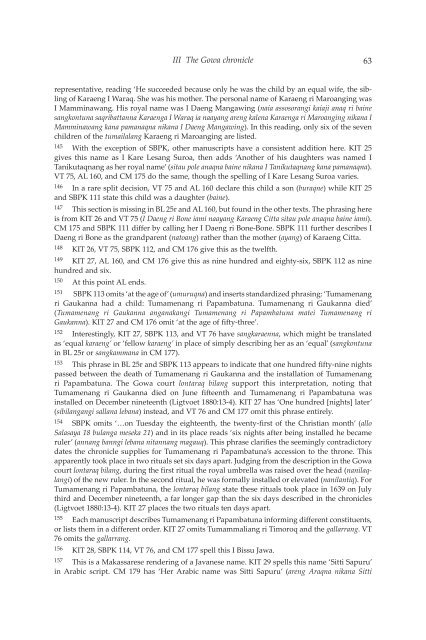A CHAIN OF KINGS - Books and Journals
A CHAIN OF KINGS - Books and Journals
A CHAIN OF KINGS - Books and Journals
Create successful ePaper yourself
Turn your PDF publications into a flip-book with our unique Google optimized e-Paper software.
III The Gowa chronicle 63<br />
representative, reading ‘He succeeded because only he was the child by an equal wife, the sibling<br />
of Karaeng I Waraq. She was his mother. The personal name of Karaeng ri Maroanging was<br />
I Mamminawang. His royal name was I Daeng Mangawing (naia assosorangi kaiaji anaq ri baine<br />
sangkontuna saqribattanna Karaenga I Waraq ia naayang areng kalena Karaenga ri Maroanging nikana I<br />
Mamminawang kana pamanaqna nikana I Daeng Mangawing). In this reading, only six of the seven<br />
children of the tumailalang Karaeng ri Maroanging are listed.<br />
145 With the exception of SBPK, other manuscripts have a consistent addition here. KIT 25<br />
gives this name as I Kare Lesang Suroa, then adds ‘Another of his daughters was named I<br />
Tanikutaqnang as her royal name’ (sitau pole anaqna baine nikana I Tanikutaqnang kana pamanaqna).<br />
VT 75, AL 160, <strong>and</strong> CM 175 do the same, though the spelling of I Kare Lesang Suroa varies.<br />
146 In a rare split decision, VT 75 <strong>and</strong> AL 160 declare this child a son (buraqne) while KIT 25<br />
<strong>and</strong> SBPK 111 state this child was a daughter (baine).<br />
147 This section is missing in BL 25r <strong>and</strong> AL 160, but found in the other texts. The phrasing here<br />
is from KIT 26 <strong>and</strong> VT 75 (I Daeng ri Bone iami naayang Karaeng Citta sitau pole anaqna baine iami).<br />
CM 175 <strong>and</strong> SBPK 111 differ by calling her I Daeng ri Bone-Bone. SBPK 111 further describes I<br />
Daeng ri Bone as the gr<strong>and</strong>parent (natoang) rather than the mother (ayang) of Karaeng Citta.<br />
148 KIT 26, VT 75, SBPK 112, <strong>and</strong> CM 176 give this as the twelfth.<br />
149 KIT 27, AL 160, <strong>and</strong> CM 176 give this as nine hundred <strong>and</strong> eighty-six, SBPK 112 as nine<br />
hundred <strong>and</strong> six.<br />
150 At this point AL ends.<br />
151 SBPK 113 omits ‘at the age of’ (umuruqna) <strong>and</strong> inserts st<strong>and</strong>ardized phrasing: ‘Tumamenang<br />
ri Gaukanna had a child: Tumamenang ri Papambatuna. Tumamenang ri Gaukanna died’<br />
(Tumamenang ri Gaukanna anganakangi Tumamenang ri Papambatuna matei Tumamenang ri<br />
Gaukanna). KIT 27 <strong>and</strong> CM 176 omit ‘at the age of fifty-three’.<br />
152 Interestingly, KIT 27, SBPK 113, <strong>and</strong> VT 76 have sangkaraenna, which might be translated<br />
as ‘equal karaeng’ or ‘fellow karaeng’ in place of simply describing her as an ‘equal’ (sangkontuna<br />
in BL 25r or sangkammana in CM 177).<br />
153 This phrase in BL 25r <strong>and</strong> SBPK 113 appears to indicate that one hundred fifty-nine nights<br />
passed between the death of Tumamenang ri Gaukanna <strong>and</strong> the installation of Tumamenang<br />
ri Papambatuna. The Gowa court lontaraq bilang support this interpretation, noting that<br />
Tumamenang ri Gaukanna died on June fifteenth <strong>and</strong> Tumamenang ri Papambatuna was<br />
installed on December nineteenth (Ligtvoet 1880:13-4). KIT 27 has ‘One hundred [nights] later’<br />
(sibilangangi sallana lebana) instead, <strong>and</strong> VT 76 <strong>and</strong> CM 177 omit this phrase entirely.<br />
154 SBPK omits ‘…on Tuesday the eighteenth, the twenty-first of the Christian month’ (allo<br />
Salasaya 18 bulanga meseka 21) <strong>and</strong> in its place reads ‘six nights after being installed he became<br />
ruler’ (annang banngi lebana nitannang magauq). This phrase clarifies the seemingly contradictory<br />
dates the chronicle supplies for Tumamenang ri Papambatuna’s accession to the throne. This<br />
apparently took place in two rituals set six days apart. Judging from the description in the Gowa<br />
court lontaraq bilang, during the first ritual the royal umbrella was raised over the head (nanilaqlangi)<br />
of the new ruler. In the second ritual, he was formally installed or elevated (nanilantiq). For<br />
Tumamenang ri Papambatuna, the lontaraq bilang state these rituals took place in 1639 on July<br />
third <strong>and</strong> December nineteenth, a far longer gap than the six days described in the chronicles<br />
(Ligtvoet 1880:13-4). KIT 27 places the two rituals ten days apart.<br />
155 Each manuscript describes Tumamenang ri Papambatuna informing different constituents,<br />
or lists them in a different order. KIT 27 omits Tumammaliang ri Timoroq <strong>and</strong> the gallarrang. VT<br />
76 omits the gallarrang.<br />
156 KIT 28, SBPK 114, VT 76, <strong>and</strong> CM 177 spell this I Bissu Jawa.<br />
157 This is a Makassarese rendering of a Javanese name. KIT 29 spells this name ‘Sitti Sapuru’<br />
in Arabic script. CM 179 has ‘Her Arabic name was Sitti Sapuru’ (areng Araqna nikana Sitti









![Am HaSefer [Volk des Buches] - Books and Journals](https://img.yumpu.com/20648352/1/174x260/am-hasefer-volk-des-buches-books-and-journals.jpg?quality=85)







